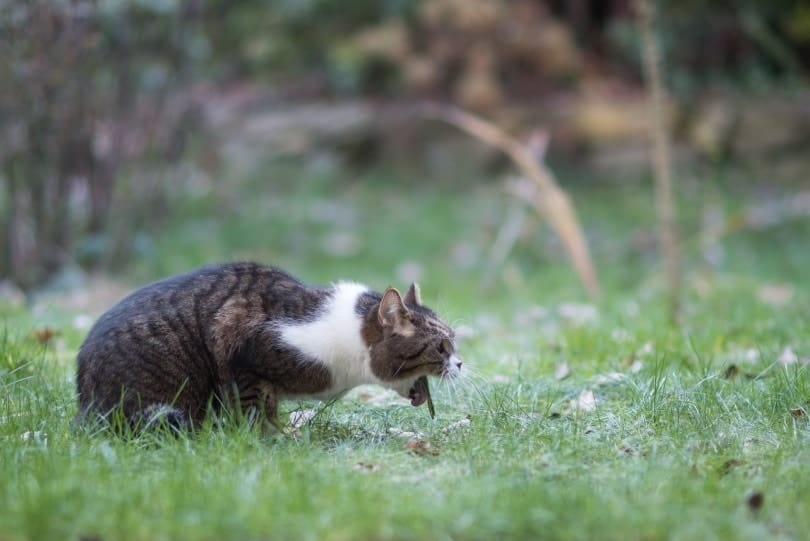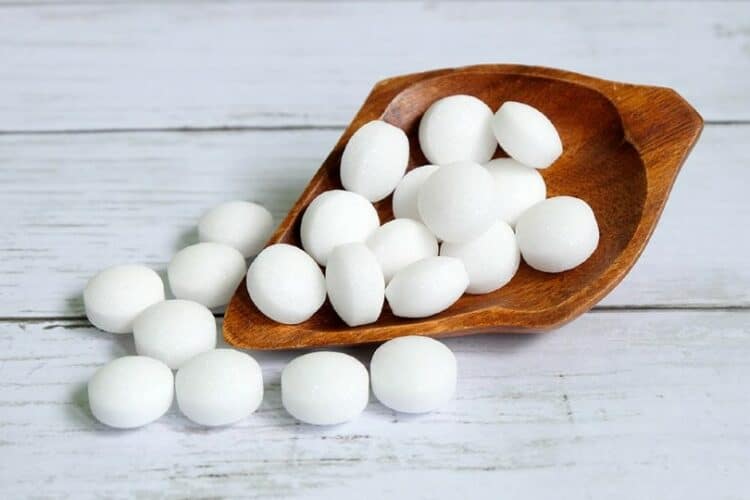Mothballs are helpful since they keep those pesky moths from eating your clothes. Unfortunately, mothballs are toxic for cats. So, you’ll want to keep them safely out of reach of any curious felines.
If your cat has eaten mothballs, you should contact your veterinarian immediately. Mothball toxicity is rare in cats since they rarely go out of their way to dig through your clothes to eat things that smell terrible but can present some unique complications.
Your veterinarian will have the most comprehensive view of your cat’s typical behavior and will be able to make the best judgments as to whether your cat needs to be brought in for observation. The early veterinary intervention will ensure the best overall outcomes for your cat’s health.
Mothball Toxicity: What Does It Look Like?
According to the ASPCA Animal Poison Control Center, mothball poisoning in pets is quite rare. The APCC reports just 158 cases between 2002 and 2004. Most cases of mothball toxicity in pets involve an animal ingesting some or all the mothball. Still, the toxic fumes that mothballs use to keep moths away can also cause toxicity.
What kind of symptoms your pet experiences will be dependent on what type of mothball they were exposed to. Not all mothballs are made equal. Mothballs can be made with two active ingredients: naphthalene and paradichlorobenzene. These chemicals can be purchased as balls, flakes, cakes, or crystals. But all forms are toxic to cats.
Naphthalene is roughly twice as toxic as paradichlorobenzene. So, buying mothballs made with paradichlorobenzene is an excellent way to reduce your cat’s toxicity risk. Symptoms of toxicity between the two chemicals are different. So, knowing which chemical is in your mothballs is critical to your pet’s safety.
Symptoms of Naphthalene Toxicity
- Vomiting
- Lack of appetite
- Anemia
- Brown-colored mucus membranes
- Weakness
- Lethargy
- Seizures
- Cataracts
- Liver damage
Symptoms of naphthalene poisoning can occur from breathing the compound’s fumes and dermal contact but are most severe when the mixture is ingested. After being eaten, pet parents will see the most common symptom of naphthalene poisoning: gastrointestinal distress. But the longer the naphthalene is in the system, the more problems arise.
Naphthalene causes damage to the red blood cells and liver. When a cat is left with naphthalene in their system for a longer period, it can eventually lead to anemia and liver failure. This toxicity can quickly become fatal. So, get your cat medical attention before it’s too late!

Symptoms of Paradichlorobenzene Toxicity
- Vomiting
- Lack of appetite
- Disorientation
- Tremors
- Difficulty walking
- Drooling
- Depression
- Seizures
- Cataracts
- Liver damage
At first glance, the symptoms of paradichlorobenzene poisoning look very similar to naphthalene poisoning. The early signs of toxicity are also gastrointestinal distress marked by vomiting. However, paradichlorobenzene causes damage to the nervous system rather than the blood cells.
Skin contact with paradichlorobenzene isn’t harmless as it can cause burning and local irritation, but it rarely causes toxicity.
The fumes produced by both chemicals can irritate the affected pets’ nose, eyes, and lungs. They may experience red, runny eyes, nose, and sneezing and coughing.
How to Keep Your Cat Safe from Mothballs
Mothballs are highly dangerous to pets. So, the best way to keep them safe is not to have mothballs in the house. There are plenty of solutions for moths that don’t contain the harmful chemicals associated with traditional mothballs. Choose products that don’t contain naphthalene or paradichlorobenzene for the safest home you can provide for your pets.
Final Thoughts
It can be hard to imagine a world without our pets, and luckily, we have a lot of natural solutions we can choose from to keep our pets safe from harm. Mothball toxicity in cats is a big deal; you should take it seriously by not welcoming mothballs into your home.
Once again, if you think your cat has ingested something toxic, contact your veterinarian immediately. They will have the best tools to ensure your cat’s health and well-being are protected.
Featured Photo Courtesy: Shutterstock














